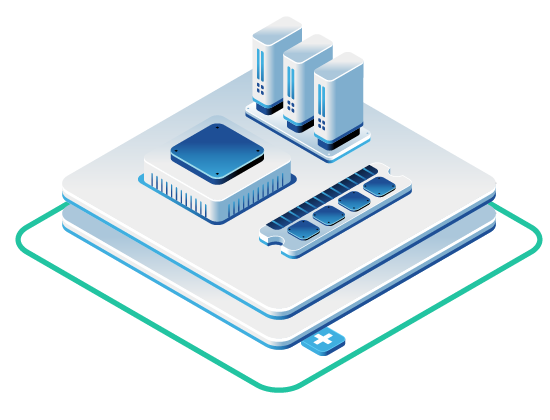In this article
- Why the Hybrid Approach Makes Sense for Your Organization
- The OpenMetal Advantage in Hybrid Architecture
- The Network: The Make-or-Break Factor
- Economic Advantages of Hybrid Private Cloud
- Security Considerations in Hybrid Architecture
- Implementation Strategy: Making the Transition Smooth
- Workload Placement Strategy
- Measuring Success in Your Hybrid Environment
- Looking Forward: The Future of Hybrid Infrastructure
- Getting Started with Your Hybrid Journey
Bottom Line Up Front: The narrative that everything must move to the cloud is outdated. Smart businesses are augmenting their existing data centers with private cloud rather than pursuing complete replacements, gaining on-demand flexibility while preserving security and existing investments.
The cloud migration conversation has shifted. Where once the debate centered on “when” to move everything to the cloud, forward-thinking IT leaders now ask a different question: “How do we build hybrid on-premises and private cloud architectures that maximize our existing investments while gaining cloud benefits?”
You’re not alone if you’re questioning the all-or-nothing cloud migration narrative. According to Cisco’s 2022 Global Hybrid Cloud Trends report, 82% of IT leaders have embraced hybrid cloud approaches, with nearly half implementing multiple cloud environments. This shift represents more than a trend, but a strategic recognition that hybrid architectures deliver superior value for organizations with significant on-premises investments.
Why the Hybrid Approach Makes Sense for Your Organization
Traditional cloud migration strategies often ignore a fundamental truth: your existing on-premises infrastructure represents substantial capital investment and operational expertise that shouldn’t be discarded lightly. Hybrid cloud solutions combine on-premises infrastructure with cloud storage, giving organizations the best of both worlds.
The smart strategy for businesses with existing on-premises investments is augmentation rather than replacement. This approach allows you to maintain the security and investment value of your on-premises environment while gaining the on-demand flexibility and managed hardware benefits of cloud infrastructure. Think of it as expanding your capabilities rather than abandoning your foundation.
Consider these practical scenarios where hybrid architecture shines:
Capacity Expansion Without CapEx Delays Your on-premises cluster approaches capacity limits. Instead of dealing with slow and expensive hardware procurement cycles, you can spin up an OpenMetal cloud on demand and treat it as an expansion pod. Move development and test workloads to free up on-premises resources for production workloads that require the lowest possible latency or highest security controls.
Specialized Workload Economics Your organization needs GPU clusters for AI/ML workloads or large-memory analytics servers, but you don’t want the capital expenditure of purchasing specialized hardware that may have variable utilization. Run these specialized jobs on dedicated OpenMetal hardware, with results feeding back to on-premises systems over low-latency private networks.
The OpenMetal Advantage in Hybrid Architecture
OpenMetal’s hosted private cloud is built on OpenStack and Ceph, providing API-first infrastructure with integrated block and object storage. This architecture ensures compatibility with Kubernetes orchestration and infrastructure-as-code workflows, delivering a full cloud environment rather than just managed servers, making it truly hybrid-friendly.
The platform offers 45-second deployments of new private clouds and 20-minute scaling when adding servers to existing clusters. This stands in sharp contrast to traditional CapEx procurement cycles that can take months and traditional managed hosting timelines measured in weeks.
Hardware Customization for Hybrid Needs OpenMetal’s extensive hardware customization includes GPU servers and clusters for AI/ML and HPC workloads, XL/XXL configurations for high-memory or compute-intensive needs, and hardware customizations like RAM upgrades and NVMe 7500 series drives. For organizations handling sensitive data, OpenMetal’s v4 servers support Intel TDX and confidential computing capabilities, strengthening security for hybrid deployments where sensitive workloads need to remain partly on-premises while using cloud capabilities for other functions.
The Network: The Make-or-Break Factor
Hybrid architectures require fast and cheap connections between environments. Without proper networking, you end up with two separate infrastructure silos rather than a cohesive hybrid system.
OpenMetal is an east-west traffic optimized cloud where included 20Gbps private networking ensures communication between on-premises and hosted environments is fast and incurs no additional cost. This approach differs significantly from public cloud egress fees that can make hybrid architectures prohibitively expensive.
Each server includes 10Gbps uplink to the public network with 20Gbps total across both NICs, plus DDoS protection up to 10Gbps and support for bringing your own IP blocks. Public traffic uses 95th percentile billing for overages rather than the per-GB taxation that public cloud users face.
Economic Advantages of Hybrid Private Cloud
Understanding the economics is crucial when evaluating hybrid approaches. OpenMetal’s pricing model is based on fixed monthly costs for dedicated hardware rather than usage-based metering. You pay for full server access including compute, memory, storage, and network capacity.
Each deployment typically starts with a minimum Cloud Core of three bare metal servers provisioned with OpenStack and Ceph, with no per-VM licensing fees. Pricing is determined by hardware configuration rather than virtual workloads created, delivering 30-60% cost savings compared to public cloud providers for workloads that can utilize dedicated hardware efficiently.
This predictable cost structure makes budgeting simpler and eliminates the surprise bills that can accompany public cloud usage spikes. For organizations with consistent workloads, this model provides significant advantages over consumption-based pricing.
Security Considerations in Hybrid Architecture
Hybrid solutions allow sensitive data to be stored on-premises while less confidential data utilizes cloud resources. This approach addresses regulatory requirements while providing operational flexibility.
Your organization maintains complete control over data classification and placement decisions. Critical financial records or personally identifiable information can remain in your on-premises environment, while development environments, backups, or analytics workloads can leverage cloud scalability and managed services.
OpenMetal’s private cloud architecture provides enhanced security through dedicated hardware that isn’t shared with other tenants. You have root-level access to install and configure any security measures necessary, from specialized firewalls to compliance monitoring tools.
Implementation Strategy: Making the Transition Smooth
The complexity of hybrid environments requires careful planning and skilled management. OpenMetal provides engineer-assisted onboarding for smooth hybrid integration, helping you design network connectivity, workload placement strategies, and operational procedures.
Ramp pricing options help avoid duplicate environment costs during migration phases. You can gradually shift workloads while maintaining operational continuity, testing hybrid connectivity and performance before committing fully to the new architecture.
Phase 1: Assessment and Design Evaluate your existing workloads to identify candidates for cloud extension. Development and test environments often make excellent initial targets, as they typically have lower availability requirements and benefit from cloud scalability.
Phase 2: Network Integration Establish secure, high-bandwidth connectivity between your on-premises environment and OpenMetal infrastructure. Configure routing, firewalls, and monitoring to ensure seamless communication between environments.
Phase 3: Workload Migration and Optimization Begin with non-critical workloads to validate connectivity and performance. Use this phase to refine operational procedures and staff training before migrating production workloads.
Workload Placement Strategy
The key to successful hybrid architecture lies in intelligent workload placement. Organizations typically keep sensitive or mission-critical data on-premises while leaning on cloud resources for scalability, computing power, and advanced analytics.
On-Premises Candidates:
- Production databases with strict latency requirements
- Applications subject to regulatory compliance requirements
- Legacy systems that are difficult to migrate
- Workloads requiring specialized hardware already owned
Private Cloud Candidates:
- Development and test environments
- Backup and disaster recovery systems
- Analytics and machine learning workloads
- Temporary projects requiring additional capacity
- Applications requiring GPU or high-memory configurations
Measuring Success in Your Hybrid Environment
Successful hybrid implementations require monitoring and optimization across both environments. Key metrics include network latency between sites, cost per workload across environments, security incident response times, and overall system availability.
Regular assessment helps identify opportunities to rebalance workloads as business needs evolve. What starts as a capacity expansion might evolve into a full disaster recovery strategy or development environment standardization.
Looking Forward: The Future of Hybrid Infrastructure
The hybrid model represents the maturation of cloud strategy. Rather than viewing on-premises and cloud as competing alternatives, forward-thinking organizations recognize them as complementary components of a comprehensive infrastructure strategy.
As data sensitivity and regulatory requirements continue to evolve, hybrid architectures provide the flexibility to adapt workload placement while maintaining operational efficiency. Your hybrid strategy today becomes the foundation for whatever changes tomorrow brings.
Getting Started with Your Hybrid Journey
Building hybrid on-premises and private cloud architecture doesn’t require abandoning your existing investments. With OpenMetal’s on-demand private cloud, you can begin exploring hybrid capabilities without upfront hardware costs or lengthy deployment cycles.
The 45-second cloud deployment capability means you can test hybrid connectivity and workload performance without long-term commitments. Engineer-assisted onboarding ensures your hybrid integration follows best practices from the start.
Your organization’s hybrid cloud journey begins with understanding that cloud adoption doesn’t mean cloud replacement. It means cloud augmentation – expanding your capabilities while preserving your investments and maintaining control over your most critical assets.
Ready to explore how hybrid architecture can transform your infrastructure strategy? OpenMetal’s team of cloud specialists can help you design a hybrid approach that aligns with your technical requirements, regulatory needs, and budget constraints. Just get in touch!
Schedule a Consultation
Get a deeper assessment and discuss your unique requirements.
Read More on the OpenMetal Blog


































